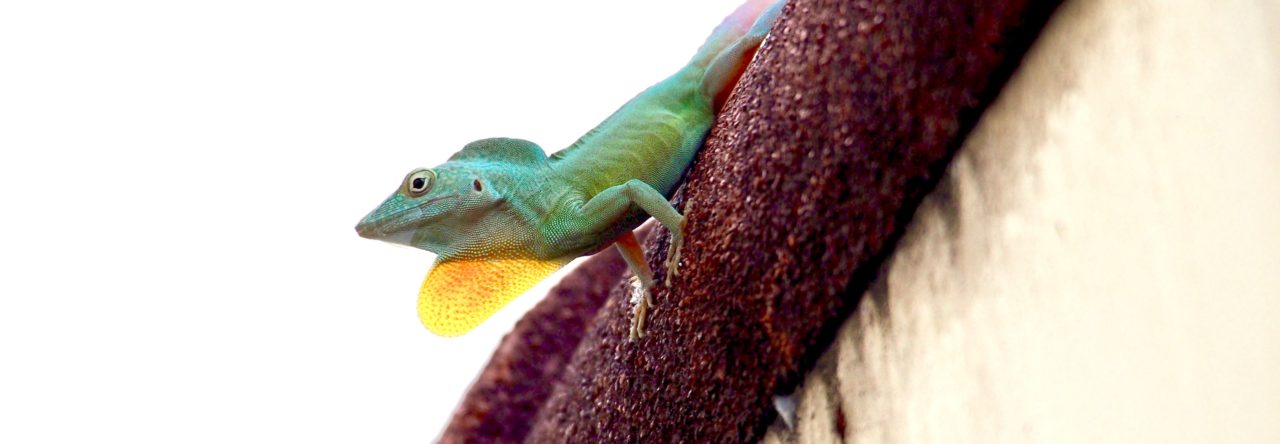Several days ago, Manuel Leal, Liam Revell and I went to Cambalache State Forest in Puerto Rico, west of San Juan. We were there to search for anoles, particularly–the giant Puerto Rican anole, Anolis cuvieri—and other fauna and flora. The trip was a great success, culminating in an action-packed interaction between three—count ‘em, three!—A. cuvieri. Manuel has already posted some observations over on Chipojolab, but Rashomon-style, I’ll present my take on what went down.
At about 2 p.m., we were walking along when a female—our fourth cuvieri of the day—was spotted head down at a height of about six feet on a tree trunk. After observing it for a few minutes, we noticed that there was a male about four feet above her on the same trunk. We watched them do nothing for a while, the inactivity perhaps caused in part by our peering and approaching for photographs.
 After a while, the female walked across a narrow branch to the next tree, performing some small headbobs as she did so. After a while more, the male started displaying (see photo), but the female studiously ignored him. Finally, the male came over to the female, who immediately ran away, up the tree. The male ran after her and caught up with her. She seemed to be playing hard to get—if she’d really wanted to get away, why did she stop and let the male get to her? He then approached her from behind in typical male fashion and grabbed onto her by biting the back of her neck. She, however, would not allow him to mate, keeping her body pressed firmly to the branch.
After a while, the female walked across a narrow branch to the next tree, performing some small headbobs as she did so. After a while more, the male started displaying (see photo), but the female studiously ignored him. Finally, the male came over to the female, who immediately ran away, up the tree. The male ran after her and caught up with her. She seemed to be playing hard to get—if she’d really wanted to get away, why did she stop and let the male get to her? He then approached her from behind in typical male fashion and grabbed onto her by biting the back of her neck. She, however, would not allow him to mate, keeping her body pressed firmly to the branch.
After this went on for a while, another male comes tearing over through the canopy from another tree and chases the first male down to the ground, where he runs to a nearby tree. The female takes off and disappears up the tree. The second male then goes back up the tree. After a while, the first male—who had turned very brown—moves over to a nearby tree, slowly resumes his green color, and starts nodding. The two males bob and look menacingly at each other, but they are separated by a distance too great to jump across. At the beginning, the second male flashed his dewlap a lot and presented an open mouth tongue display, but as time went on and the old male regained his greenness, these behaviors waned. Both males continually moved up their respective trees, neither seeming to want to let the other be higher. As the trees bent in opposite directions, moving up caused the males to become further and further apart. After a while, male #2 turned dark and seemed to adopt a submissive pose, whereas male #1, who had been chased off, had a victorious pose. How the two of them had decided that #1 had won is a mystery.

Males posturing at each other from a distance. Photo by M. Leal at Chipojolab
So, what went on? Was the female being unreceptive because #1 was an interloper and she was waiting for her guy to come by? Given that #2 started from another tree and eventually retreated back to it, that doesn’t seem to be the case. Was she mating publicly and prominently to attempt to attract other males, as Trivers suggested for the Jamaican giant A. garmani? Another point is that the interaction, although aggressive, involved little or no physical contact (couldn’t quite tell what happened when the second male rushed the first one at the outset); these two males may be old acquaintances and were simply reminding each other of where their territory boundaries lies. Notably, as well, when the two males were displaying back and forth, it seemed at times like one or the other was thinking about attacking, but the distance between the trees was too great to bridge in a jump. The only other avenue would have been to go to the ground and run over to the other tree, and then attack from below, which would seem to put that male at a disadvantage according to the laws of gravity.
I am unaware of any reports in the literature on A. cuvieri territorial or mating behavior, so these observations are interesting and perplexing. As Manuel states, this shows the importance of getting out and observing animals in their natural habitats—we’ve got a lot left to learn.
- Evolution in Real Time on Lizard Island - March 23, 2025
- Spider Snags Adult Anolis osa - March 22, 2025
- An Homage to the Green Anoles of New Orleans - March 21, 2025





Manuel Leal
As shown by this photo, Liam is also developing a strong interest in sexual size dimorphism in spiders. A logical extension of his work in anoles.